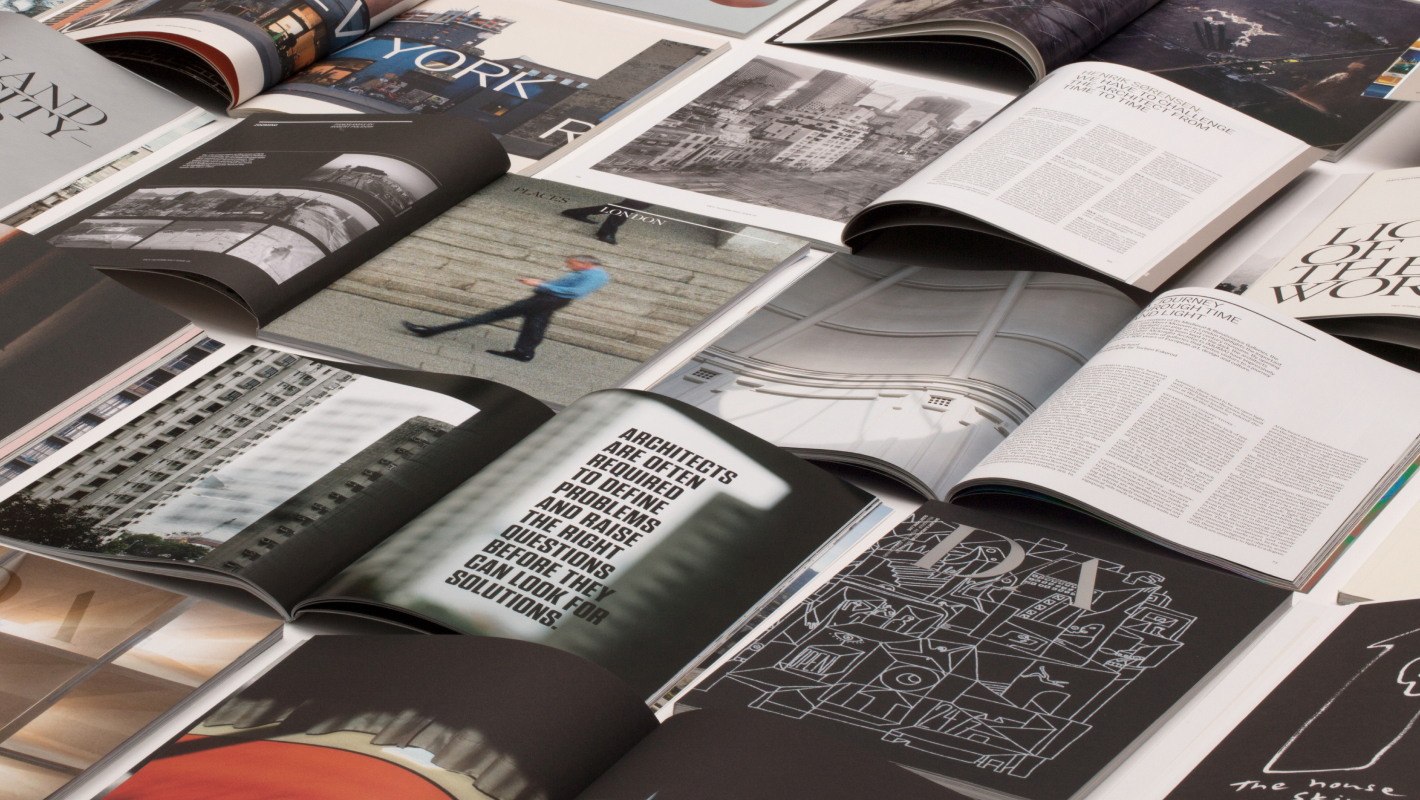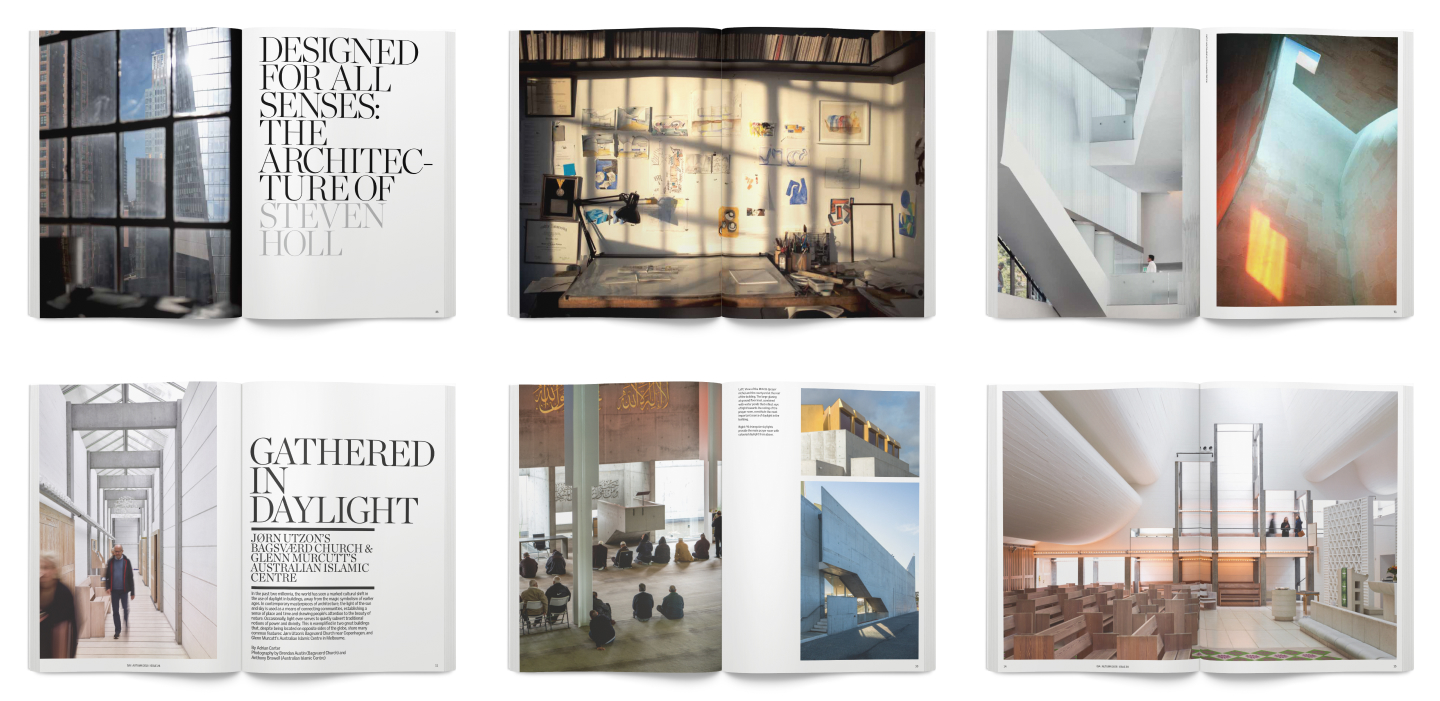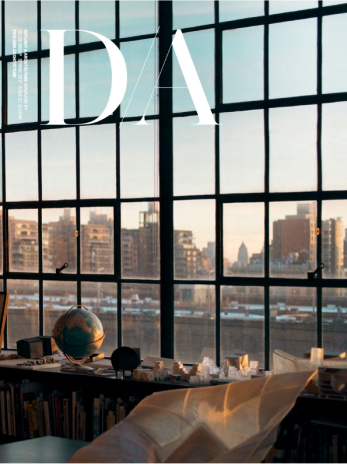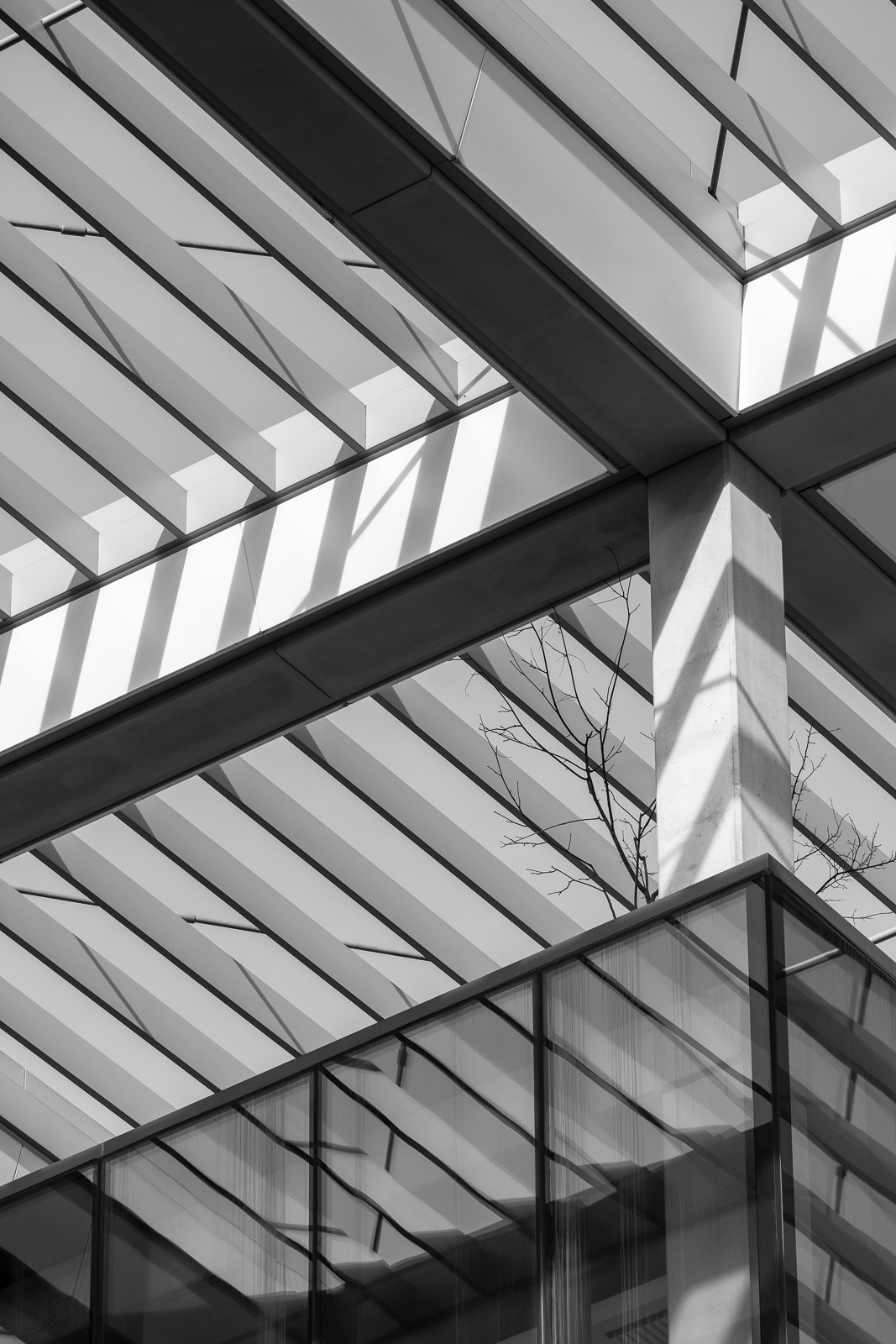Rethinking daylight:
the history of the Daylight
& Architecture Magazine

Category
Daylight & Architecture
Author
Jakob Schoof
Photography
SDL
Date
01 JUN 2022
Source
Daylight & Architecture
Share
Copy
We usually don’t spend much time thinking about the elements that surround us in our everyday lives. Especially not when we receive them every day for free, like daylight.
And yet the light of the sun enriches our lives again and again: as a source of health and well-being, as an inexhaustible form of energy, and as a centuries-old component of our art and building culture. In 2005, VELUX launched the Daylight&Architecture Magazine to sharpen our awareness of this fact and to advance the discourse on natural light. As a manufacturer of roof windows and skylights, the daily business of VELUX is closely linked to daylight provision in buildings and the company´s vision for the magazine has therefore been to encourage practicing architects and researchers to explore and work with daylight as one of the most fundamental parameters of architecture.
29 issues of D/A Magazine have been published between 2005 and 2018. It was a process of constant reinvention, exciting discussions and many discoveries that went far beyond architecture. The message of D/A Magazine was a cultural one, not a commercial one. This fact has certainly contributed to the magazine’s great esteem among all those interested in daylight. It was also recognized by the numerous juries that repeatedly awarded the magazine prizes, both for its graphic design and its editorial content. Browsing through the articles and interviews on this web platform, you will find that they are still worth reading today, and we are proud to know that D/A Magazine is still present on the bookshelves of many architects around the world.
A healthy dose of daylight
Just a few years before D/A Magazine was launched, scientists had discovered a new photoreceptor in the eye that determines our sleep-wake rhythm. Yet this receptor only develops its full effect at much higher light levels than those commonly found indoors today. “We live our lives in dim caves,” claimed neurophysiologist Russell Foster of Oxford University in D/A #15. The message of British architect and writer Peter Buchanan was very similar three years later in D/A Magazine: “Over time we have progressively removed ourselves from form and denied our dependencies upon the natural world, and moved out of sync with its rhythms.”
The question of how much light at what time of day or night is good for people is still a matter of concern for researchers today. In D/A #26, lighting practitioner and sleep expert Deborah Burnett explained how daylight affects our biology and circadian system, an impact that goes far beyond vision. The essence of her contribution: “The eye is designed to use light, not (only) look at it.”
Bridging science and architecture
How can insights into people’s sleep-wake rhythms, adaptive comfort and indoor well-being be translated into better buildings? This is another question that experts such as Koen Steemers, John Mardaljevic, Jennifer Veitch and Anna Pellegrino have pondered time and again in D/A Magazine. The fact that a healthy indoor climate also pays off financially was made clear by Marilyne Andersen, laureate of the Daylight Award for her research in 2016: “Good daylighting might save a few percent in terms of energy costs, but what proportion of the overall building cost does this represent? Almost nothing. In terms of wellbeing, productivity and health however, daylight can make a huge difference.”
Vivian Loftness made a similar calculation in “The importance of windows for environmental surfing” in D/A #23: The building as a surfboard instead of a supertanker, equipped only with a minimum of technology and driven solely by the forces of nature. This ideal can rarely be fully achieved in architecture, but the vision increasingly fascinates architects today. The fact that it turns many standards and conventions in building design on their head was made clear by Austrian engineer and indoor climate expert Peter Holzer in D/A #25: “Taken seriously, the design of healthy buildings calls into question many established standards and parameters in building design, from indoor temperature levels to how much – and what kind of – light we let inside our offices and living rooms.”
“Over time we have progressively removed ourselves from form and denied our dependencies upon the natural world, and moved out of sync with its rhythms.”
The measurable and the immeasurable
“The art of daylighting involves much more than merely allowing the right amounts of natural light into a building. Acts of great architectural imagination may transform the utilitarian functions of daylighting – the measurable – into places of great beauty – the unmeasurable,” wrote Dean Hawkes in 2011 in an essay on daylighting in the architecture of great masters from Sir Christopher Wren to Peter Zumthor.
The tension between measurable properties of spaces and their effect on people, which cannot always be quantified, is something we have explored time and time again in D/A Magazine. “Comfort is a state of mind,” says Bernd Wegener, professor emeritus of sociology at Humboldt University in Berlin. Together with his colleague Moritz Fedkenheuer, he has developed the Housing Well-Being Inventory – a method for determining the well-being of people in buildings. Their model was presented in D/A #23. The underlying insight: Whether people feel comfortable in their environment is not determined solely by environmental stimuli, but also by their inner attitudes and affects.
Well-being cannot be prescribed or planned – people must be asked about it. This view is also shared by Bill Bordass and Fionn Stevenson, two pioneers of post-occupancy evaluation, in their 2011 interview with D/A Magazine. The core question of the conversation was: How to create better buildings that people are satisfied with because they actually work in practice? To this Bill Bordass states: “More than anything, the process entails a change of attitude in mind – to see the job of producing a building as not just finishing it off as a physical object, but in getting it to work.”

Sustainable architecture
Under the headline, “The House that gives more than it takes”, D/A # 13 opened a series of articles about the pioneering buildings that VELUX has developed together with architects, engineers and builders in recent years. The buildings offer their occupants maximum daylight and fresh air, save resources and are CO2-neutral wherever possible. VELUX thus follows the philosophy of its founder Villum Kann Rasmussen: “One experiment is better than a thousand expert views”. In our articles, our key focus has been the experiences of the occupants with these buildings – because after all, even the best design concepts are just as good as they turn out to be in practice, when people use the buildings on a daily basis.
And they appreciate the added value of daylight: “There is a wonderful light and view in Home for Life”, wrote the Simonsen family in 2009 about the Home for Life in Lystrup near Aarhus. A few years later, their successors in the house, the Kristensen family, added: “It has been interesting to experience that the house reacts – in some cases it even feels like the house acts as a direct function of human needs.”
Daylight is (almost) everywhere
Much unlike architecture, daylight is dynamic – it changes all of the time, its character being determined by the time of day and year, but also by the local climate and topography. The 29 issues of Daylight&Architecture are a visual proof of this. Over the years we have had the privilege of working with some of the best photographers in Europe to define the unique visual identity of D/A Magazine. Coordinated by our photo editors Adam Mørk and Torben Eskerod, who travelled to such diverse places as Texel in the Netherlands, Preikestolen in Norway and Phoenix in Arizona to capture the magic of daylight in architecture for us. Masterpieces of architecture such as Lacaton & Vassal’s Tour Bois-le Prêtre in Paris and Hiroshi Sambuichi’s Naoshima Hall in Honmura, but also classics like Jan Duiker’s open-air school in Amsterdam and Jørn Utzon’s Bagsvaerd Church near Copenhagen were all featured in our magazine in an unusual perspective, true to life and occasionally with humoristic connotations. The photographers we worked with had one thing in common: the interest in the life that takes place in the buildings and its traces. One of the most extraordinary journeys to light, however, was provided to us by astrophysicist Michael Linden-Vørnle in D/A #19, as he described the way in which light originated, the form it appears in today and how all light may eventually end. His article “First Light” was accompanied by fascinating imagery of the afterglow from Big Bang, which cosmologists had compiled shortly before using ESA’s Planck satellite.



Light of tomorrow
Anyone who has felt the enthusiasm of young up-and-coming architects devoted to experimenting and working with daylight is inevitably moved by it. Since 2004, the International VELUX Award for Students of Architecture has encouraged students to work with daylight. In 2014, D/A #21 featured ten years of inspiration and innovation in the award under the title “The future is light”, and paid tribute to the close to 4,000 daylight projects received up to that point.
In its statement in 2008, the jury summed up what was special about the competition: “What the jury was looking for was not necessarily complete or buildable projects, but merely projects that celebrated the privilege of bringing a student – with the naivety intact, with curiosity, with the willingness to take a risk and with a mindset for experimental thinking out of the box.”
The bigger picture
Daylight in buildings is vital, yet the challenge of good daylighting also has implications on a larger scale. Legal battles have already been fought over the “Right to Light” in densely built cities. Hence the light between buildings – or, more broadly speaking, sustainability on an urban scale – has been an important topic in several issues of D/A Magazine. D/A #12, “Flows,” was published 2009 to coincide with the UN Climate Change Conference COP15 in Copenhagen. The magazine takes a look at the possible future of cities in 2050 and shows potential solutions for the major urban challenges – from population growth, climate adaptation, water and energy supply to the important question of how much daylight is available to people in increasingly densely populated metropolises.
In D/A #18, citizens of Rio de Janeiro, London and Phoenix were in focus: What challenges are urban dwellers facing today in order to ensure a healthy life tomorrow? What kind of dynamic drives urban communities forwards, and according to what rules do cities transform themselves? The answers showed the different challenges faced by metropolises around the world. And their relationship to daylight is, of course, fundamentally different.
This highlights the need for site-specific approaches to urban daylighting such as the study “What about Daylight?”, which we presented in D/A #19. One of the authors, Signe Kongebro of Henning Larsen Architects, told us: “Many architects need to get used to the idea that sustainable building is not just a question of technology or insulation and that daylight has a considerable effect on the energy balance in buildings.”
Danish author Tor Nørretranders put it even more fundamentally in his article in D/A #12: “The flow of daylight is a ubiquitous and soft gift, all that we on this planet need from the cosmos outside to stay active and happily alive. The task ahead is to build a civilisation based on that simple fact. … Reuse. Recycle. Go with the flow. Be soft and gentle. Just add daylight.”


Light versus darkness
We need daylight to stay healthy. But dark nights are just as important for the health of people, animals and plant life. Both cannot be taken for granted in industrialized societies, as the U.S. writer and advocate of the Dark Skies Movement, Paul Bogard, argued in an essay for D/A #25: “We have taken what was once one of the most common of human experiences – walking outside and coming face to face with the universe – and made it one of the most rare.”
In D/A #24, Olafur Eliasson told us how useful even the smallest amounts of light can be. He recounted summer evenings in his childhood in Iceland, when electricity was rationed and twilight outside was the only source of light: “Sitting by the window with this very atmospheric light made me aware, not just of the difference between incandescent light and daylight, but that you could actually use this little bit of blue light.” In 2016, Eliasson and his social business, Little Sun, teamed up with the VELUX Group to bring solar-generated light into off-grid regions of the world. This enables disadvantaged households to do away with inefficient and polluting kerosene lamps and cut down on their fuel costs. Yet, as Eliasson told us, what really counts for people is the emotional value of light: “Maybe we should not always try to quantify everything but just do something for the potential of feeling good and happy.”
Unique points of view
Many artists have left their mark on D/A Magazine over the years – from Dan Perjovschi with his laconic and humorous line drawings in D/A #13 to Jesper Waldersten, who enriched the 22nd issue of our magazine with his collages of text, drawings and photographs. Every single D/A Magazine has its own creative concept and unique cover. Great creative efforts have been put into making all issues different and surprising. Take for instance, Lars Arrhenius’ unique cartoon drawings for the cover of D/A #16 “Life Cycles” and Simon Schubert’s unique artwork in D/A #26. Using only white, folded paper, the Austrian artist manages to depict the subtle effects of light and shade in indoor spaces with a stunning degree of complexity – a fitting complement to Juhani Pallasmaa’s essay “Dwelling in Light” in the same issue.
The photography and illustrations in D/A Magazine have sometimes been bold and experimental, sometimes sensual and subtle, and often with a humorous twinkle in the eye. In our last edition, D/A #29, we even ventured into a new form of storytelling together with Danish graphic novelist Halfdan Pisket. In his story, “How Buildings Shape Us”, he illustrates a person’s fictional conversation with the space all around him. The effects of daylight and fresh air on human well-being are being discussed here in a manner never seen before – close to life and with plenty of hands-on advice on what it takes to create a good indoor climate.
“We are born of light. The seasons are felt through light. We only know the world as it is evoked by light.”
Behind the scenes
Less visible, but no less important, were the discussions and efforts that went into the creation of each issue of D/A Magazine. I remember a freezing cold visit to IBA 13 in Hamburg, a pleasant spring outing to the Green Solution house near Rønne in Bornholm, and a roundtable talk at the Arup Head Office in London. Add to that countless working meetings in all sorts of places in and around Copenhagen, including some of the exemplary buildings that VELUX has helped to build over the past decade and a half. D/A Magazine was created by a multidisciplinary team of architects, communication experts, art directors and photographers, with each individual bringing unique ideas to the process. I’m delighted that this legacy now lives on in a new digital format and will be continually expanded in the years to come. Because whatever the future may bring, one challenge will persist: to foster the interdisciplinary collaboration between building professionals in order to create healthy buildings with plenty of daylight and fresh air. Louis Kahn knew this when he wrote: “We are born of light. The seasons are felt through light. We only know the world as it is evoked by light.”




